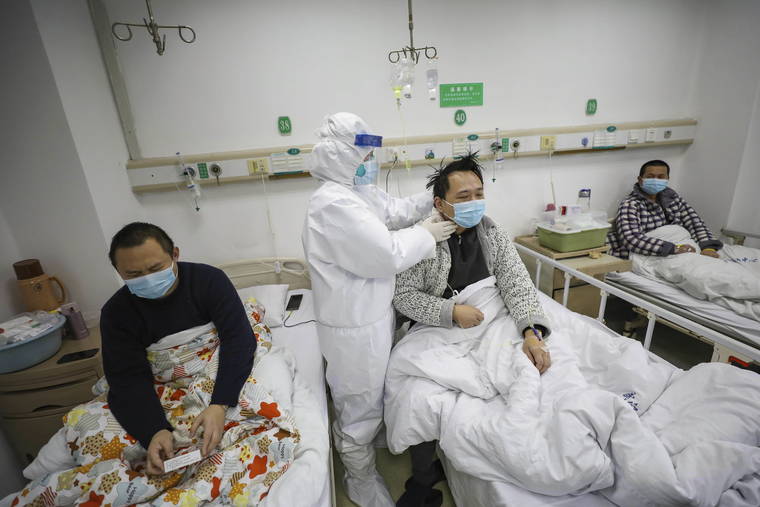BEIJING — China reported a surge in deaths and infections from a new virus Thursday after changing the way the count is tallied, further clouding an epidemic that has stirred fear as it spread to more than two dozen countries.
The spike came after two days in which the number of new cases dropped and brought little clarity for those desperate to understand the trajectory of the outbreak.
“What we need is some consistency over time to give us an idea of what’s actually happening,” said Dr. William Schaffner, an infectious disease expert at Vanderbilt University in the United States. “Is transmission happening or is it not?”
The answer has proved frustratingly elusive despite the official reports.
The death toll in China from the disease known as COVID-19 reached 1,367, up 254 from a day earlier, and the number of confirmed cases jumped to 59,804, up 15,152.
Dr. Michael Ryan, the World Health Organization’s emergencies chief, said the dramatic increase was due to a revised way of counting cases and cautioned it did not represent a sudden surge in new infections.
“This increase you’ve all seen in the last 24 hours is largely down to how cases are being diagnosed and reported,” he said, noting that the jump in infections refers to patients that go back days and weeks, including back to the beginning of the outbreak.
China’s National Health Commission said officials in Hubei province, whose stricken capital of Wuhan is the virus’ epicenter, began tallying cases using a lower bar of “clinical diagnosis.” That appears to count cases based on doctors’ analyses and lung imaging rather than relying solely on laboratory test results. More than 13,000 of the newly-reported infections were a result of the new way of counting.
A spokesman for China’s health commission, Mi Feng, said the change was aimed at identifying suspected cases in which the patient has pneumonia so they can be treated quicker and reduce the likelihood of more serious illness or death. It was also seen as a reflection of a chaotic crush of people seeking treatment and the struggle to keep up with a backlog of untested samples.
“Clearly in Wuhan, the healthy system is under extreme pressure and so the first priority has to be the patient,” said Mark Woolhouse, a professor of infectious disease epidemiology at the University of Edinburgh.
In further clues to the desperate attempt to contain the virus and public criticism of the government’s efforts, China replaced two more high-level officials — the ruling Communist Party chief in Hubei and the party secretary in Wuhan. Those followed the sacking earlier in the week of two leaders of the provincial health commission and reports from state media of a slew of others expelled from the party for missteps related to the epidemic.
The public has widely criticized local officials for failing to respond quickly and decisively to the new virus. Authorities initially assured people that there was little to no risk of human-to-human transmission, a statement that was later retracted. Wuhan residents said hospitals were overcrowded and lacked sufficient medical supplies. Doctors who tried to share information early on were reprimanded by police for “spreading rumors.”
“This is a society struggling with openness,” said Schaffner. “For people like that who continue to be in positions of authority, to change their thinking must be difficult. So you have to be a bit skeptical when you see these changes in case definition.”
Paul Hunter, a professor of health protection at the University of East Anglia in England, expressed similar frustration with the revised numbers, but said he believed it didn’t represent a change in trajectory for the outbreak.
“I suspect but can’t be certain that the underlying trend is still downwards,” he said. “It almost certainly does not mean that there has been a resurgence of the epidemic overnight.”
Many countries have implemented travel restrictions on recent visitors to China, which has more than 99% of the world’s reported COVID-19 infections.
In an unprecedented measure to contain the disease, the Chinese government has placed the hardest-hit cities — home to more than 60 million — under lockdown. One district in Shiyan, a city in Hubei, has implemented “wartime measures,” barring residents from leaving even their apartment compounds for two weeks.
According to a local government notice, neighborhood committees will distribute basic necessities at a fixed time and at fixed prices, as well as help residents purchase any medicine they might urgently need.
Xu Min, a resident of Shiyan’s Zhangwan district, said her neighborhood entrance was being guarded by community workers and security staff.
“It doesn’t have too much of an impact on our life, except that we’re not allowed to go out,” Xu said.
The impacts continued to be felt far beyond China, though.
Japan reported its first death — a woman in her 80s — the third fatality outside of mainland China, following deaths in the Philippines and Hong Kong.
Japan’s Health Ministry announced Thursday that 44 more people on a cruise ship quarantined in the port of Yokohama, near Tokyo, have tested positive for COVID-19. The ship has 218 infections among its 3,700 passengers and crew.
Another cruise ship, the Westerdam, finally docked Thursday in Cambodia after being turned away by several Asian and Pacific governments. No cases of the viral illness have been confirmed among its passengers and crew, according to operator Holland America Line.
In Vietnam, official media reported that a village of 10,000 northwest of the capital, Hanoi, was put in lockdown due to a cluster of cases there.
———
Associated Press writers Mike Stobbe in New York; Mari Yamaguchi in Tokyo; Sopheng Cheang in Sihanoukville, Cambodia; Grant Peck in Bangkok; Maria Cheng in London and researchers Liu Zheng and Yu Bing in Beijing contributed to this report.
———
This story corrects the number of confirmed cases in mainland China to 59,804, not 52,526.


